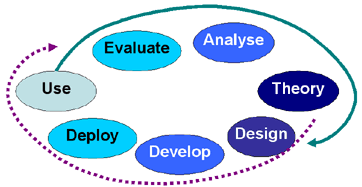
Methodology: Design-Based Research
Some time ago I read Community Indicators: a framework for observing and supporting community activity on Cloudworks by Galley et al. (2014) which proposes four key factors which underpin successful online collaborative groups: participation, cohesion, identity and creative capability. Before digging deeper into these aspects of community experience, I was pulled towards the methodology component of this research, otherwise known as Design-Based Research. But what exactly is DBR?
According to the Learning Theories website DBR is:
- a lens or set of analytical techniques that balances the positivist and interpretivist paradigms and attempts to bridge theory and practice in education
- a blend of empirical educational research with the theory-driven design of learning environments
- an important methodology for understanding how, when, and why educational innovations work in practice
- a method which aims to uncover the relationships between educational theory, designed artefact, and practice.
DBR is something I am very interested in because I see enormous value in including practitioners in the research process. These guys are on the front-line, they have the most relevant input to give you, and the most to gain from you. And yet academic research papers containing very practical research results, aka gold dust. :), remain quite inaccessible for most teachers, hidden behind university library (pay) walls, and, even worse, deemed boring, or too difficult to interpret. (It’s true, I actually felt like that reading this very paper!) I guess I am doing my part by sharing my notes and thoughts here on my blog. ..if only there were people out there reading it..!
My Research Methodology
Moving on. Galley et al. (2014) enlisted a three-dimensional research approach covering: data analysis, observation & interviews and surveys. And indeed, as I think about how I would collect data in order to analyse the success of my own Masters course as an (intellectually!) progressive online community, I think I would adopt a similar approach. Of course I would first have to choose which aspect of Konstantinidis & Goria’s (2016) proposed online community framework I would like to focus – Social presence & Identity, Cognitive & Creative presence or Teaching Presence & Cohesion.
Data Analysis would be possible – by referring to the dialogue we, the students, engaged in on the Moodle learning platform in relation to one or more of the strategies listed above. I believe I need permission to access this data. Observation would not be possible – as our live course is now over – although I suppose it would be possible to observe the discursive and deliberate interactions of the current cohort in action with the correct permissions. And finally, Interviews and surveys would be possible – and probably the most exciting, as it would mean contacting my old classmates and getting (anonymous?) feedback on their learning experience.
Dissertation: Next Steps
Referring to my previous post, I should select the ‘least researched’ area, which is not yet apparent from my initial readings. But I am sure it will come to light as my knowledge of this area increases. Keep going, K!
References
Galley, R.,, Conole, G. & Alevizou, P. (2012). Community Indicators: A framework for observing and supporting community activity on Cloudworks. Interactive Learning Environments, 22(3), 373-395.
Konstantinidis, A., & Goria, C. (2016). Cultivating a community of learners in a distance learning postgraduate course for language professionals. In S. Papadima-Sophocleous, L. Bradley & S. Thouësny (Eds), CALL communities and culture – short papers from EUROCALL 2016 (pp. 230-236).
Image
Pinterest – https://www.pinterest.com/idabrandao/design-based-research/
